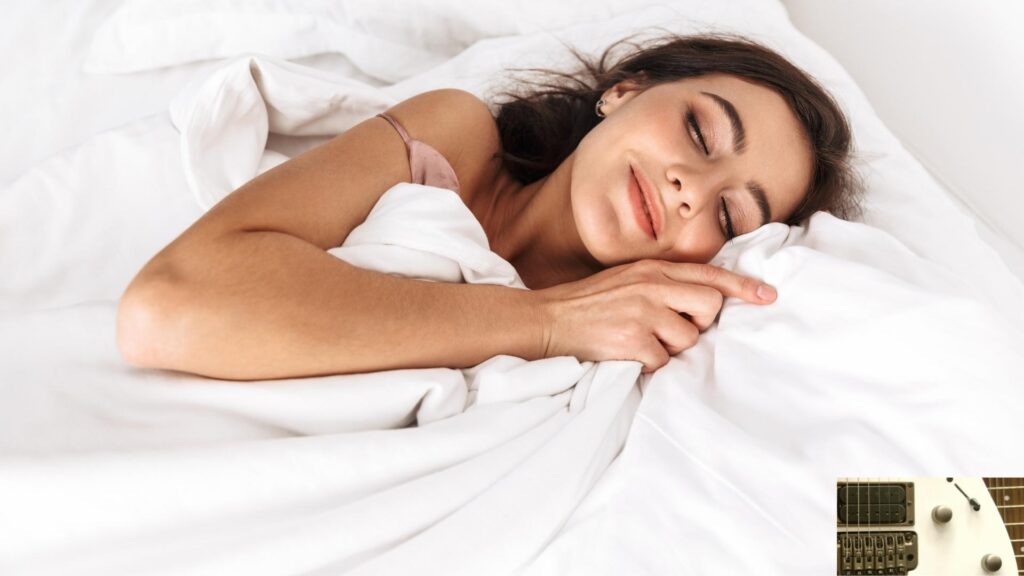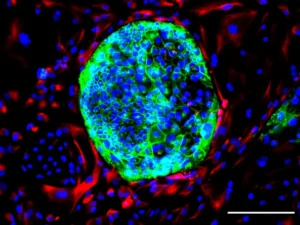Key Points:
- Studies have shown that white noise can hasten your normal sleep-wake cycle.
- Pink noise has more power at lower frequencies and less at higher frequencies, making it deeper.
- Brown noise has greater bass in the lower frequencies due to the change in energy or power.
- Pediatricians suggest keeping any white noise machines at least 7 feet away from your baby’s crib.
If you’re here to find a way to “see” noise, you are not in luck. White noise is random noise that has a flat spectral density—that is, the noise has the same amplitude, or intensity, throughout the audible frequency range (20 to 20,000 hertz). It got its name “white noise” because it’s analogous to white light, which is a mixture of all visible wavelengths of light.
White noise blocks out other sounds and has been shown to signal to the brain that it is time to sleep. Your brain will learn to associate white noise with sleep more quickly the more often you listen to it. Studies have been shown to improve the accuracy of pure sounds. According to studies, white noise can hasten your normal sleep-wake cycle.
My bedtime routines cause me a significant amount of stress. I’ve spent a great deal of time reading up on this topic in the literature, carefully testing out various methods. I’ve finally discovered methods that have helped me, and I can now impart my experience in this article.
White noise may assist with bedtime rituals, but it doesn’t merely improve sleep. Additionally, it generally improves people’s moods and gives them more self-assurance to take on difficulties and problems throughout the day. White noise will enhance their cognitive skills, discipline, and ability to form positive habits.
There are more colors besides “white” that are related to noise. For instance, pink noise contains audible frequencies, with lower frequencies increasing and higher frequencies decreasing. Deep and even sound is generated. Examples comprise:
-Powerful wind
-Waves, crashing on the beach
-Leaves, rustling
-Rain, beating down

All audible to the human ear, noise frequencies are included in both pink noise and white noise. However, white noise contains all frequencies with equal distribution. Whereas, pink noise has more power at lower frequencies and less at higher frequencies, making it deeper.
The only sound type named for a person, Robert Brown, rather than a color, is brown noise.
White noise and brown noise both produce sounds at random, but in brown noise, frequency increases as energy decreases and vice versa. Keep in mind that white noise is the sum of all frequencies with equal energy. It has greater bass in the lower frequencies due to the change in energy or power, which makes brown noise different. This varies from pink noise in a subtle sense because pink noise loses power as the frequency of its notes rises.
Without a doubt, all three of them enhance your capacity to sleep. Which, though, is the best?
White noise masks outside sounds in a similar way to pink noise. But because it includes all frequencies, white noise may be more effective at keeping out sleep-inducing noises.
According to research, sleep interruption is even worse than having no sleep. When Johns Hopkins University School of Medicine assistant professor of psychiatry and behavioral sciences, Patrick Finan, the study’s lead author, compared the mood ratings of the three groups, he found that both interrupted and short-sleepers experienced drops in positive mood after the first night. But on the following nights, the short sleepers did not—they stayed at around the same level they had reported after the first night—while the interrupted sleepers continued to report falling good feelings.
Regardless of what the participant’s scores on the negative mood scale were, this decline in positive mood still occurred. According to Finan, a lack of sleep may decrease a happy mood more than it can enhance negative emotions.
People who regularly hear traffic at night are more likely to have heart disease and take sleep medicines. But this only partially improves their sleep. White noise reduces the influence of noise, enabling you to sleep longer and deeper and reducing the need for sedatives.
We must meet two equally important goals while trying to fall asleep: falling asleep quickly and staying asleep. If you wake up after 20 minutes, it can be unpleasant and hard to get back to sleep for the required amount of time.
White, pink, and brown noise, the three different types of sleep noises, all aid in sleeping. White noise reduces the likelihood of sleep disturbance, which is a problem worse than having trouble falling asleep because it helps keep outside sounds from waking you up during the middle of the night.
Pediatricians suggest keeping any white noise machines at least 7 feet (200 cm) away from your baby’s crib in light of the AAP results. White noise has been shown to improve sleep in individuals of all ages. White noise devices shouldn’t be louder than what’s safe for infants. Additionally, keep in mind that some newborns may not respond well to white noise and that babies can build a dependency on it.
Add this up with the fact that your brain starts associating white noise with sleep, and you can see how using white noise for a better night’s sleep can be a useful tool for adults who suffer from insomnia too. Using white noise is an effective way to help keep your brain relaxed for the long term.
- AI-Powered PCs: Overhyped Trend or Emerging Reality? - August 21, 2024
- Princeton’s AI revolutionizes fusion reactor performance - August 7, 2024
- Large language models could revolutionize finance sector within two years - March 27, 2024


